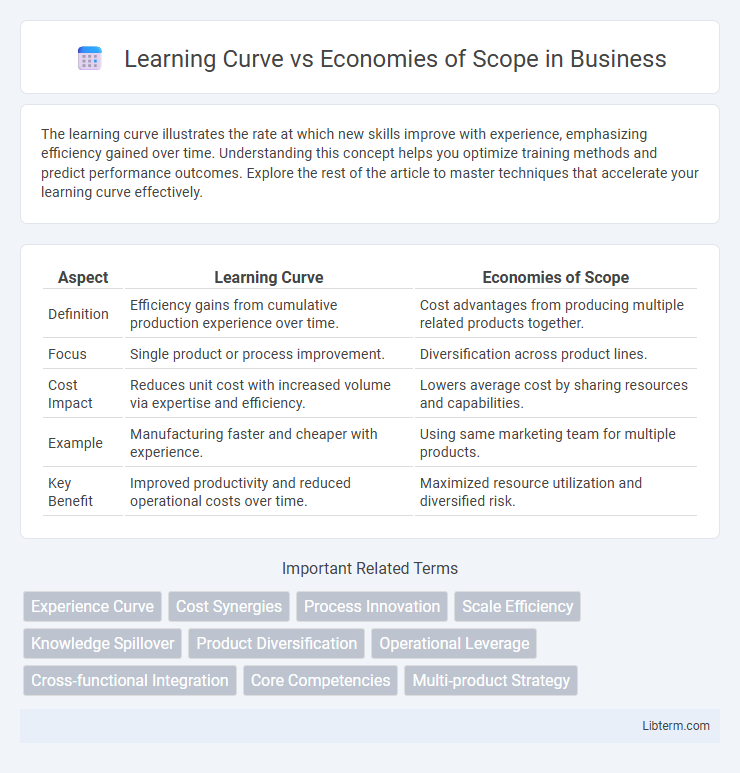The learning curve illustrates the rate at which new skills improve with experience, emphasizing efficiency gained over time. Understanding this concept helps you optimize training methods and predict performance outcomes. Explore the rest of the article to master techniques that accelerate your learning curve effectively.
Table of Comparison
| Aspect | Learning Curve | Economies of Scope |
|---|---|---|
| Definition | Efficiency gains from cumulative production experience over time. | Cost advantages from producing multiple related products together. |
| Focus | Single product or process improvement. | Diversification across product lines. |
| Cost Impact | Reduces unit cost with increased volume via expertise and efficiency. | Lowers average cost by sharing resources and capabilities. |
| Example | Manufacturing faster and cheaper with experience. | Using same marketing team for multiple products. |
| Key Benefit | Improved productivity and reduced operational costs over time. | Maximized resource utilization and diversified risk. |
Introduction to Learning Curve and Economies of Scope
The learning curve illustrates how increased production experience reduces average costs through efficiency gains and improved skills. Economies of scope arise when producing multiple products together lowers overall costs compared to producing them separately, leveraging shared resources or capabilities. Understanding these concepts helps businesses optimize cost structures by balancing specialization with diversified production.
Defining the Learning Curve in Business Operations
The learning curve in business operations quantifies the rate at which efficiency improves as workers gain experience with repetitive tasks, typically resulting in reduced costs and time per unit produced. It highlights the correlation between cumulative production volume and performance gains, emphasizing skill acquisition and process refinement. This contrasts with economies of scope, which focus on cost advantages from producing diverse products using shared resources.
Understanding Economies of Scope
Economies of scope arise when a company efficiently produces a variety of products together, reducing average costs by sharing resources, technology, or processes. This concept contrasts with learning curves, which focus on cost reductions from increased production of a single product through experience and efficiency gains. Understanding economies of scope is crucial for identifying opportunities to leverage multi-product synergies and enhance competitive advantage through cost diversification.
Key Differences: Learning Curve vs Economies of Scope
The learning curve describes cost reductions achieved through increased production efficiency over time, emphasizing cumulative experience in a single product or process. Economies of scope refer to cost advantages realized by producing multiple related products simultaneously, leveraging shared resources and capabilities. The key difference lies in the learning curve focusing on improvements in a single activity, while economies of scope capitalize on diversification and resource sharing across products.
Factors Influencing the Learning Curve
The learning curve is primarily influenced by factors such as labor efficiency, technological advancements, and cumulative production experience, which enable cost reductions as output increases. Workforce skill improvement and process innovation accelerate the decrease in per-unit costs over time. These factors differentiate the learning curve from economies of scope, which depend more on the cost advantages gained through diversified product lines and shared resources.
Drivers Behind Economies of Scope
Economies of scope arise primarily from the shared use of resources, technologies, and capabilities across multiple products or services, reducing average costs and enhancing operational efficiency. Key drivers include the integration of marketing networks, manufacturing facilities, and R&D efforts, which create synergies and lower expenses through diversified business activities. Firms leveraging economies of scope benefit from cost advantages by producing related products together rather than separately, increasing competitiveness and market responsiveness.
Applications of the Learning Curve in Various Industries
The learning curve concept demonstrates how increased production experience reduces costs and improves efficiency, prominently applied in manufacturing industries such as automotive and aerospace to optimize labor and material usage. In technology sectors, especially software development, learning curves drive productivity gains by accelerating employee skill acquisition and streamlining coding processes. Healthcare and energy industries leverage learning curves to enhance operational procedures, lower treatment costs, and improve renewable energy system efficiency over time.
Real-World Examples of Economies of Scope
Economies of scope occur when a company efficiently produces a variety of related products, lowering total costs by leveraging shared resources, such as Toyota manufacturing both cars and trucks using common platforms. Similarly, Amazon achieves economies of scope by offering cloud services (AWS) alongside retail operations, optimizing infrastructure and distribution networks. This contrasts with learning curve effects, which reduce costs through increased production volume of a single product rather than product diversification.
Strategic Implications for Businesses
Understanding the learning curve enables businesses to reduce production costs through increased efficiency and skill acquisition over time, directly impacting competitive advantage. Economies of scope allow firms to leverage shared resources across multiple products or services, enhancing diversification and market responsiveness. Strategically, integrating both concepts helps businesses optimize operational flexibility while minimizing costs, driving sustainable growth and improved market positioning.
Conclusion: Choosing the Right Efficiency Strategy
Choosing the right efficiency strategy depends on the business's operational complexity and product diversity. Learning curve effects optimize production by reducing costs through repetitive processes, ideal for standardized, high-volume manufacturing. Economies of scope create cost advantages by sharing resources across diverse product lines, benefiting firms with varied offerings and seeking flexible growth.
Learning Curve Infographic

 libterm.com
libterm.com